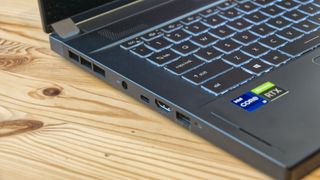TechRadar Verdict
We can’t fault MSI’s ambition, but this CPU and GPU in a portable system results in excessive fan noise and less performance than a desktop workstation. It’s also heavy and saddled with a mediocre SSD.
Pros
- +
Great performance
- +
Latest Intel silicon
- +
Good GPU for a laptop
Cons
- -
Expensive
- -
Slow NVMe drive
- -
Constant fan noise
Why you can trust TechRadar
MSI has made some outstanding gaming laptops, and the latest WS66 is an ongoing exploration of the related mobile workstation market.
There is a demand for high power laptops to avoid the inconvenience of lugging entire desktop systems around and the inevitable impact on reliability that doing that creates.
Typically these systems tend to forego an extended battery life for better processor and video performance, confident that the user will have mains power available.
Originally a 10th Gen CPU design, MSI engineers have revamped the WS66 to use the latest Intel 11th Gen Core i7, i9 or Xeon processors and combined the new platform with Nvidia Geforce RTX discrete graphics silicon.
Is the WS66 a workstation a credible way to carry a proper workstation around, or is there an underlying problem with putting desktop computing technology in a laptop?

Price and availability
MSI has three versions of the new WS66, one with the GeForce A5000 mobile GPU and 64GB of RAM, and two with the A3000 and 32GB of memory. The flagship design uses a Core i9-11900H processor and is officially priced at $4,199.
The middle-order model has the same Core i9 class processor but the less powerful A3000 GPU and costs $2,999. The cheapest WS66 option is one with a Core i7-11800H processor. The A3000 GPU and 32GB of RAM for $2,599.
These machines come with a 1TB NVMe SSD, a 1080p resolution display, the same battery size, and a Windows 10 Pro pre-installed.
There are Xeon powered versions of this machine coming, but we don’t have prices for those at this time.

Design
On the outside, there is nothing revolutionary about the WS66, as it looks practically identical to the 10th Gen platform version of this laptop.
The upper lid surface is metal skinned, with the rest of the outside being primarily plastic. Where it diverges from a conventional laptop design is in the large air vents on the rear portions of the sides, across the rear of the hinge and most of the underside at the back.
We’ll discover later in the review why it needs such excessive ventilation, but keeping things cool inside this case must have occupied a disproportionate amount of time of those engineering it.
Typical we’d talk about the layout inside, but MSI put a label marked ‘Factory Seal’ over one of the screws on the underside, indicating that they don’t want people going in there, for whatever reason.
Overall, this is a well constructed and designed system, and the changes from the previous model are primarily internal.

Hardware
Here is the MSI WS66 configuration sent to TechRadar for review:
CPU: Core i9-11900H
Graphics: Nvidia GeForce A5000 Mobile
RAM: 64GB DDR4 RAM
Screen: 15.6" FHD (1920*1080), Finger Touch panel
Storage: Phison 1TB SM2801T24GKBB4S-E162 NVMe SSD
Ports: 1 x Thunderbolt 4 USB-C (compatible with USB 3.2 Type-A Gen 2), 1 x USB 3.2Gen2/DP, 3 x USB3.2 Gen2 Type-A, 1 x HDMI, 1 x universal audio jack
Connectivity: Killer AX1675x Wireless Network adapter, RealTek 2.5GbE LAN adapter, Bluetooth v5.2
Camera: 1x IR & 720p HD Camera with Microphone
Security: Fingerprint Reader, Windows Hello via IR camera, dTPM 2.0 Chip
Weight: 2.1kg/ 4.63lbs
Size: 358.3 x 248 x 19.8 mm (W x D x H)
Battery: 4 cell 99.9Whr Li-Polymer
There are other aspects of the new WS66 that we could talk about, but the two highest-profile parts are the 11th Gen CPU and the RTX A5000 GPU.
The review hardware used an Intel Tiger Lake chipset and Core i9-11900H CPU with eight cores and 16 thread processing.
Early 11th Gen CPUs from Intel were very disappointing as they were all quad-core, but the later designs like this Core i9 demonstrate the enhancements in single-thread performance and better power efficiency.
Power consumption is critical on a mobile system. A configurable limit of 45W TDP on this chip and a turbo mode that boosts from standard 2.5GHz up to 4.9GHz allows for some computational sprinting.
Ironically, the integrated GPU is also significantly improved. But on this system, it largely remains inactive due to the Nvidia A5000 discrete graphics.
On paper, the A5000 GPU is based on the same Ampere architecture as the GTX 3080 that gamers have admired but been unable to afford since crypto-miners bought them all.
There is only one snag, the video card in this laptop is a mobile A5000 and not a desktop A5000, a confusing naming convention that appears designed by Nvidia to convince customers that they have something they do not.
The chip code for the desktop A5000 is GA102, and the mobile A5000 uses a GA104 offering 6144 unified shaders and a 256bit wide memory bus achieving 384GB/s bandwidth. In comparison, the desktop A5000 has 8192 shaders, a 384-bit wide memory bus and 768 GB/s of bandwidth.

Those are significant differences, and to get a fuller flavour of the performance gap, we tested a Boston Workstation machine that used a desktop A5000 and achieved 9665 in the 3DMark Port Royal raytracing test and this laptop managed just 5,889.
Admittedly that didn’t factor the different CPUs in those tests, but we’d contest that the mobile A5000 is about half what the desktop GPU is, and that’s reflected in the amount of power that the video card can consume in the WS66, a fraction of the 230W that the desktop GPU can pull.
Good equivalent desktop GPUs would be the RTX 3060 or RTX 2070, making the mobile A5000 appear markedly less special for those needing GPU performance above all else.
Overall, the performance of the WS66 for a laptop is good. But, it’s not a credible replacement for a fully specified desktop workstation platform, being realistic.
- 1
- 2
Current page: Introduction, price, design and hardware
Next Page In use, performance and verdictMark is an expert on 3D printers, drones and phones. He also covers storage, including SSDs, NAS drives and portable hard drives. He started writing in 1986 and has contributed to MicroMart, PC Format, 3D World, among others.


